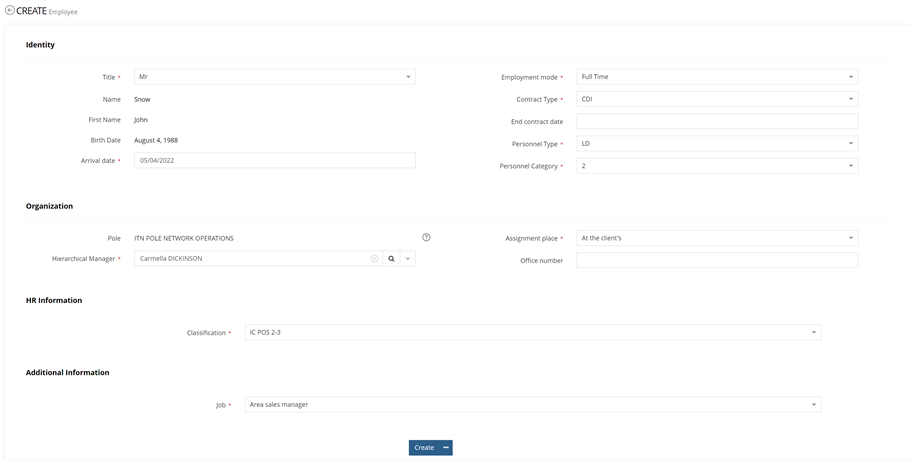Identity Creation & Activation (Joiner)
Identities can be created via different means in Memority:
Form Creation: Memority allows to configure custom forms to manually create an identity.
Import: Memority can process data collected via API or flat files and create relevant identities.
This chapter focuses on manual creation. For import-based object creations, please read this page.
For unitary identity creations, Memority offers the following elements to adapt to all client models:
A check for duplicates
A fully configurable creation form
Adaptable identity activation rules
Workflows to apply
Check for duplicates
To avoid creating duplicates of the same object, Memority provides an check for duplicates before moving on the actual identity creation. This feature is optional and can be removed if necessary.

Deduplication Check
When a duplicate is found, it is displayed to the user, which can perform one of the following actions (see screenshot below):
Create the identity anyway: a new account is created. Both accounts eventually link to different users
Add a sibling account to an existing user: a new account is created. Both accounts eventually link to one single user
Update an existing user: no new account is created.

Duplication Found
The available options are configurable by features. Choices could vary based on the identity type (e.g. only internal users can have sibling identities).
Configurable creation form
Depending on the user and its access rights/scope in Memority, functional administrators can use the creation forms configured on the tenant. These forms can be different depending on the identity type that needs to be created (Internal, External, Technical, …) and allows to fill all attributes defined in its data model.
Memority allows to create custom forms based on the identity type to be created (different forms for internal and external users). Each form can include different fields (e.g. “Supplier” only for external identities), trigger different workflows (e.g. derogation workflow for internal users) or even form visibility (External identity creation form only visible to internal admins).

Creation Feature Example
In addition, Memority allows to configure different rules to manage:
Mandatory attributes
Scoping attributes
Auto-filled attributes depending on the connected administrator or another context information (e.g. manager attribute is pre-filled by the user filling the form).
Notification sent to the beneficiary, his manager, the approvers, etc…
Identities (objects more globally) can be created from an authoritative source (more information can be found in this page)
Adaptable identity activation rules
To adapt to all customer processes, Memority offers an adaptable way to activate or deactivate identities.
Memority allows to configure activation or deactivation rules for an identity:
Activation can be scheduled (when the start date is reached, activate the user), immediate (activate identity upon creation) or even require approval from an administrator.
Deactivation can be scheduled (when the end date is reached, deactivate the user) while its impacts can be configured (lose all accesses upon deactivation or gradually lose them over a defined time period).
Suspension can be limited in time or immediate and require an approval from an administrator to revert.
All these Joiner / Mover / Leaver processes can be adapted according to our customers needs.
